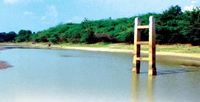New Kings and Kingdoms - Worksheets
CBSE Worksheet 01
New Kings and Kingdoms
Identify what is shown

Suice gate
Sulic gate
Sluice gate
Seli gate
Rajatarangi is a metrical historical chronicle of north-western Indian subcontinent, particularly the kings of
- Kashmir
- Rajasthan
- Gujarat
- Karnataka
- The specialists who worked at the temple and lived near it were
- All of these
- Sweeper
- Dancers
- Cook
The gate was used for

It regulated the inflow of water from a tank into the channels that irrigated the river
It regulated the outflow of water from a tank into the channels that irrigated the fields
It regulated the outflow of soil from a tank into the channels that irrigated the river
It regulated the inflow of soil from a tank into the channels that irrigated the fields
Nagabhata was the king of:
Deccan
Pratihara
Gwalior
none of these
Match the following:
Column A Column B (i) Maharaja-Adhiraja (a) Lord of the three world (ii) Kalhana (b) Kashmir (iii) Tribhuvana Chakravartin (c) A long Sanskrit poem depicting kings rule (iv) Prashastis (d) Great king, overlord of kings - Fill in the blanks:
Kadamba Mayurasharman and the Gurjara-pratihara Harichandra were ________ who gave up their traditional professions.
- State true or false:
Association of traders were Nagaram.
Bronze images made in Chola temples depict what as a subject?
What did the Samantas declare themselves later?
Who were Cholas?
Who built the two famous temples of Thanjavur and Gangaikondacholapuram? How was it maintained?
What were the conditions for becoming a member of the Sabha? What was the committee system under Chola?
CBSE Worksheet 01
New Kings and Kingdoms
Solution
- (c) Sluice gate Explanation: The given image is a ninth century sluice- gate in Tamil Nadu.
- (a) Kashmir Explanation: Rajatarangini is a metrical legendary and historical chronicle of the north-western Indian subcontinent, particularly the kings of Kashmir. It was written in Sanskrit by Kashmiri historian Kalhana in the 12th century CE.
- (a) All of these Explanation: All the specialists who worked at the temple and very often lived near it – priests, garland makers, cooks, sweepers, musicians, dancers, etc
- (b) It regulated the outflow of water from a tank into the channels that irrigated the fields
Explanation: The given image is a ninth-century sluice - gate in Tamil Nadu. It regulated the outflow of water from a tank into the channels that irrigated the fields. - (b) Pratihara Explanation: Pratihara
(i)-(d), (ii)-(b), (iii)-(a), (iv)-(c)
- Brahamanas
True
Chola bronze images are considered amongst the finest in the world. While most images were of deities, sometimes images were made of devotees as well.
They declared themselves to be maha-samanta, maha-mandaleshvara and so on.
The Cholas established a powerful empire in South India by Vijayalaya. They ruled in South India for over four centuries. Rajaraja Chola and Rajendra I were the most powerful rulers of Chola dynasty.
Rajaraja I and his son Rajendra I built the big and grand temples of Thanjavur and Gangaikondacholapuram. Both these temples were considered the best examples of architectural and sculptural works. Temples were also endowed with land by rulers as well as by others. The produce of this land went to maintain all the specialists who worked at the temple and very often lived near it - priests, garland makers, cooks, sweepers, musicians, dancers, etc. In other words, temples were not only places of worship; they were the hub of economic, social and cultural life as well. Amongst the crafts associated with temples, the making of bronze images was the most distinctive.
- For becoming a member of a Sabha, a person should be a landlord, have his own home, be between 35 and 70 years of age, must know Vedas, be well-versed in administrative matters and be honest.
- The Sabha had separate committees whose members were elected.
- The names of eligible members were written on small tickets of palm leaf.
- They were then put in an earthenware pot from which a young boy took out the names one by one for each committee.
- Sabha and Samiti thus were democratic ways of functioning in the past.
